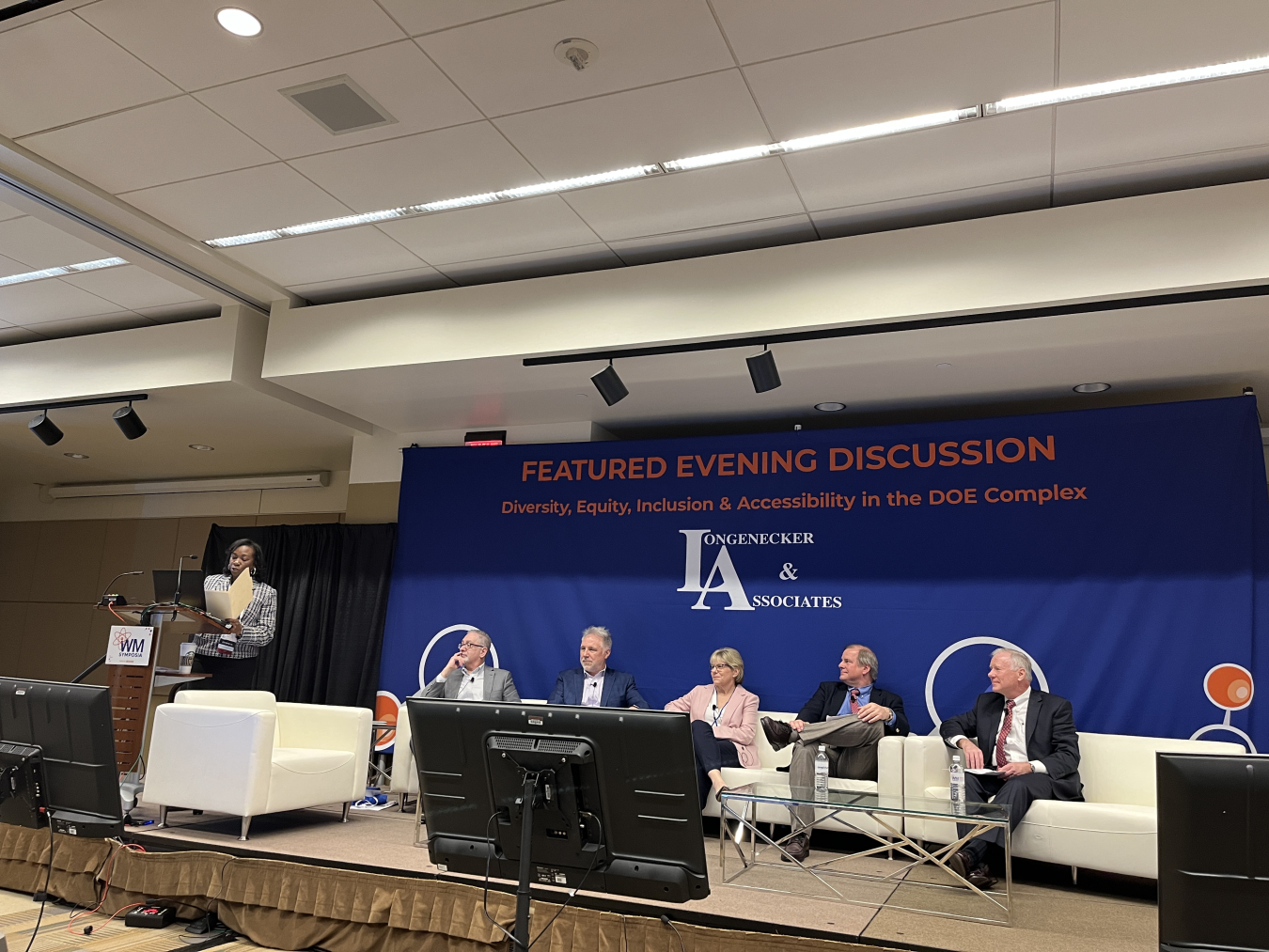Oak Ridge hosted a panel at the 2023 Waste Management Symposia titled, “U.S. DOE Environmental Cleanup in Oak Ridge, TN: A New Chapter.”
Office of Environmental Management
March 14, 2023
Oak Ridge hosted a panel at the 2023 Waste Management Symposia titled, “U.S. DOE Environmental Cleanup in Oak Ridge, TN: A New Chapter.” Participants from left include Oak Ridge Office of Environmental Management Manager Jay Mullis, UCOR President and CEO Ken Rueter, Isotek Project Manager Sarah Schaffer, Oak Ridge National Laboratory Site Office Manager Johnny Moore and Tennessee Department of Environment and Conservation Senior Advisor Patrick Flood.
PHOENIX – With numerous programs, contractors and regulators involved in the Oak Ridge cleanup mission, the site hosted a panel at the recent 2023 Waste Management Symposia highlighting how all of the organizations work together to enable progress.
Panelists shared information on projects since last year’s Waste Management conference, detailed what’s next on the Oak Ridge Reservation and explored critical milestones ahead. They also provided a full representation of the partners responsible for recent successes and plans for future achievements. The panel was titled “U.S. DOE Environmental Cleanup in Oak Ridge, TN: A New Chapter.”
Read special EM Update coverage of the 2023 Waste Management Symposia here and here.
Participants included Jay Mullis, manager of the Oak Ridge Office of Environmental Management (OREM); Ken Rueter, president and CEO of cleanup contractor UCOR; Sarah Schaffer, Isotek project manager; Johnny Moore, Oak Ridge National Laboratory (ORNL) site office manager; Glen Adams, supervisory toxicologist with the U.S. Environmental Protection Agency Region 4; and Patrick Flood, senior advisor for the Tennessee Department of Environment and Conservation.
“The main strategic vision for Oak Ridge is to reduce risks and deliver results,” Mullis said.
Speakers spotlighted how OREM and its partners are working together to transform ORNL. It involves UCOR deactivating and demolishing scores of old former reactors and isotope labs in the coming years. Progress is already underway on that front, and it’s visible.
UCOR crews recently completed the first demolition of a former reactor in ORNL’s central campus area. They tore down the Bulk Shielding Reactor, which dates back to the 1950s and has been shut down since 1991. This project is the first of many that will eliminate risks and open land for future research missions at the site.
“We’ve accomplished a lot,” Rueter said, adding that UCOR looks forward to future success as workers reduce risks and help facilitate their missions.
Crews are weeks away from starting demolition on the Low Intensity Test Reactor, which is adjacent to the site of the former Bulk Shielding Reactor.
Isotek, another OREM contractor, is working on the highest cleanup priority at ORNL. It is responsible for eliminating the inventory of uranium-233 stored at the site. That material is stored in the oldest operating nuclear facility in the world, requiring significant resources annually from DOE to keep it safe and secure.
Schaffer discussed the U-233 Disposition Project, detailing Isotek’s processing campaign that allows downblended material to be solidified and shipped for disposition.
Processing and dispositioning of the U-233 inventory will reduce costs to taxpayers, provide rare medical isotopes to advance next-generation cancer treatment research and allow OREM to demolish large old facilities in the heart of ORNL to make room for new facilities and missions.
OREM’s cleanup is directly benefiting the future of ORNL. Site Office Manager Johnny Moore discussed how the cleanup mission is enabling the science mission there. He provided information on the site’s various science and technology initiatives that are making ORNL a world leader in numerous fields. He also detailed how working collaboratively with the cleanup contractors is helping make the site safer and freeing up valuable real estate for future operations.
Regulators are another crucial element of the cleanup mission.
Adams and Flood discussed the importance of the regulatory partnership framework with OREM and highlighted how it supported the decision-making process that led to the approval of the record of decision for the site’s Environmental Management Disposal Facility.
To receive the latest news and updates about the Office of Environmental Management, submit your e-mail address.

